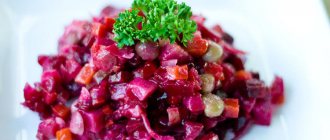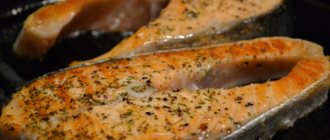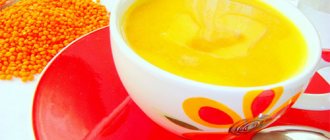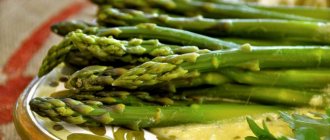If until recently you firmly believed that vinaigrette salad is an exclusively Russian dish, it’s time to find out the truth. It turns out that vinaigrette is a French dish, although it has already become a salad in the Russian culinary interpretation. But originally, vinaigrette was just a sauce and nothing more. Vinaigrette sauce was used mainly to season vegetable salads, which is why it became firmly attached to beetroot and potato salad with sauerkraut in our kitchen.
But in the French tradition, vinaigrette remained a sauce. Our favorite beetroot and potato salad is also well known there. It began to be called Russian salad there. But the French always season it with their favorite sauce.
About the sauce
What is a vinaigrette dressing?
There are several dozen variations of French sauce, but each of them is based on a combination of vegetable oil and an acidic environment. Olive, mustard, and sunflower oil can be used as vegetable oil.
Vinegar most often plays the role of an acidic environment. The most successful vinaigrette uses white wine vinegar, but you can also use apple cider vinegar and balsamic vinegar.
In addition to vinegar, lime or lemon juice, as well as any other naturally acidic juice, can be an acidic medium. For example, an unusual taste is obtained if vinaigrette sauce is made from pomegranate juice. You can also use sour dry wine.
The proportions of oil and vinegar in the dressing also remain unchanged. You can prepare vinaigrette in spoons or buckets, but the ratio of the main ingredients will always remain the same: three parts oil and one part vinegar (lemon juice).
As for additional ingredients, cooking here offers dozens of different options. And any cook or housewife can not only choose from already tried recipes, but also try their own strength to invent new varieties of the popular dressing.
How to season vinaigrette: interesting ideas, features and recommendations
The sauce plays a key role in creating the flavor of the dish. A salad made from the highest quality products will be hopelessly spoiled by an unsuccessful dressing.
Typically, salads and vinaigrettes are seasoned with butter, sour cream, mayonnaise and lemon juice. Vegetable oil is traditionally chosen for vinaigrette. But is this really the only tasty option?
Let's get acquainted with vinaigrette
Before you figure out how to season the vinaigrette instead of oil, it would be nice to understand what kind of dish it is and why mayonnaise is rarely used for it.
Vinaigrette is a salad of French origin that was originally dressed with a dressing called vinaigrette, which was a simple mixture of vinegar and olive oil.
Theoretically, you can season the vinaigrette with mayonnaise, sour cream, and unsweetened yogurt. If the vinaigrette recipe includes mushrooms and beans, it is even recommended to replace the oil with mayonnaise to emphasize the taste. However, vinaigrette “not in oil,” even if it is tasty, is a slightly different dish. But below we will consider such options.
What ingredients to use for butter dressings
What oil should I season the vinaigrette with if I don’t like olive oil? It just so happens that in Russia the most common vegetable oil is sunflower. For salads, unrefined is often used. If you are preparing a vinaigrette, then the oil is mixed with mustard or grated horseradish, vinegar and a small amount of sugar. Sometimes only oil is used without any additives.
You need to focus on the composition of the salad and taste preferences. For example, add less vinegar if there are a lot of pickled cucumbers in the dish. Or replace it with lemon or lime juice if you prefer.
The presence of sauerkraut and pickled cucumbers in the salad eliminates the need to add salt to the dressing.
If you don’t want to use either lemon or vinegar, mix vegetable oil in a 3:1 ratio with cucumber pickle. Another replacement option is white wine.
When choosing the best way to season the vinaigrette, experiment, but do not forget about the sense of proportion and compatibility of ingredients. If you choose unrefined oil, then let the vinegar have a less pronounced odor. If you prefer balsamic vinegar, then use refined oil.
Classic dressing
So, how to season a vinaigrette if a sauce made from vegetable oil suits you just fine and you don’t want any serious experiments? Let's select the ingredients:
- Oil. A flavored oil is recommended - olive or unrefined sunflower. But you can also use the usual odorless option.
- Vinegar. You can also take regular one, but it is better to prefer grape or apple. An alternative is lemon or lime juice.
- Mustard. Used for stabilization. The component is optional, but it’s interesting that even people who don’t like mustard willingly eat it as part of a vinaigrette. You can replace it with the yolk of a hard-boiled chicken egg, grated horseradish, chopped hot pepper.
- If desired and for brighter taste, the sauce is supplemented with herbs and spices. Marjoram, thyme, tarragon, basil, rosemary are optimal.
Take 3 parts oil to 1 part vinegar. Add salt (preferably coarse) and pepper to taste to the vinegar, then mix with oil. Whisk the ingredients or place them in a closed container and shake vigorously several times. If mustard is added, the oil and vinegar are mixed first.
The principle of preparing the sauce is almost always the same, only the ingredients change.
Add vinaigrette just before serving.
Interesting additions to classic dressing
Since a sauce based on oil and vinegar is the most suitable option, we’ll find out how to deliciously season a vinaigrette without deviating too much from the classic recipe.
The universal ingredient is garlic. It is enough to chop one clove and add it to a regular sauce to make the taste much richer.
Or enrich the oil-vinegar mixture with vegetables: baked and pureed pepperoni or pureed tomatoes. Using the same principle, you can add olives and capers.
An unexpected ingredient is honey. Literally 1 teaspoon per 3 tbsp. spoons of butter.
You can also finely chop the onion, mix with chopped green onions, parsley, dill and add the resulting mass to the sauce.
Dressing with egg and broth
Prepare 1 raw egg yolk, 2 tbsp. spoons of vegetable broth, 2 tbsp. spoons of butter. You will also need 3% vinegar, but its amount is adjusted to taste. Neutral option – 1 teaspoon.
Mix the broth, yolk and butter in a small saucepan and place over low heat. Stirring constantly, heat until the mixture thickens. Remove from heat and add vinegar. Cool.
Dressing with egg and capers
Grate 2 yolks from hard-boiled eggs. Add half a spoon of dry mustard, 2 teaspoons of finely chopped onions, dill and capers. Salt and pepper, pour in half a glass of 3% vinegar and ¾ cup of vegetable oil.
Mix all ingredients well and beat.
Dressing from different types of oil and vinegar
Take 3 tbsp. spoons of olive and refined sunflower oils. Add 1 tbsp. a spoonful of wine (red or white) and berry (cherry or raspberry) vinegar. Add a pinch of salt and ground black pepper.
Mix the ingredients, place in a jar and shake well.
The sauce is suitable not only for vinaigrette, but also for other vegetable salads.
When is mayonnaise appropriate in a vinaigrette?
How to season the vinaigrette for people who prefer mayonnaise and sour cream in their salads? Well, let the vinaigrette be traditionally seasoned with oil, but no one has canceled experiments. And the recipe for the salad itself does not always correspond to the canons.
The most common composition includes beets, potatoes, sauerkraut, pickles and onions. But there are many ways to make a salad more filling. For example, add meat and boiled eggs to the specified set of components. And such a salad can be seasoned with mayonnaise.
This sauce is also indispensable if beans and pickled mushrooms are added to the vinaigrette. True, in this case it is better to add mustard and lemon juice to mayonnaise to emphasize the taste characteristics of the salad.
Is it possible to season a vinaigrette with sour cream?
As in the case of mayonnaise, it is more appropriate to ask not what to season the vinaigrette with, but what to make it from.
Make a vinaigrette with boiled beets, fresh cucumbers, canned green peas, corn and red chili peppers. You will get a “Mexican vinaigrette”. Mix sour cream with herbs and season the resulting dish.
The famous film director Eldar Ryazanov even came up with his own recipe, in which he mixed mayonnaise and sour cream. One day he didn’t like the vinaigrette that was served at the hotel.
Then the artist mixed sour cream, lemon juice, mayonnaise, mustard, sugar and pepper. I added cheese, walnuts and apples to the salad.
The resulting dish cannot be called a classic vinaigrette, but Eldar Aleksandrovich was very pleased.
Is it possible to season a vinaigrette with yogurt?
And again the answer is yes. Add 1 tbsp to 150 ml of yogurt. a spoonful of apple cider vinegar, 1 chopped garlic clove, salt, pepper. Whisk everything thoroughly.
The sauce goes well with the classic vinaigrette recipe. But since we are thinking about how to season the vinaigrette to get a non-standard taste, why not go even further? For example, there is a vinaigrette recipe that involves using yogurt as a sauce. But the usual set of products has been changed.
Boil beets, parsnips and carrots. Cut into cubes. Place on a plate previously lined with lettuce leaves. Pour over yogurt dressing and sprinkle with walnuts.
Dietary dressings
Vinaigrette can be used as a diet dish. But variations in low-calorie salad recipes are limited. Only beets, potatoes, carrots, boiled beans, onions and sauerkraut. It is even recommended to exclude potatoes or use them in small quantities. But green peas are allowed.
Vegetables are boiled and finely chopped. The salad is dressed with olive oil, low-fat kefir, low-fat cottage cheese or natural yogurt.
If in doubt
If people with such different taste preferences gather at the table that you have no idea what you can season the vinaigrette with to please all the eaters, then simply give the guests a choice.
Place several types of sauces on the table, not forgetting about regular mayonnaise and vegetable oil without additives. By dressing the salad directly on your plate, each guest will be able not only to choose the sauce to their taste, but also to try several variations of the same dish.
What else you need to know about vinaigrette dressings
The taste of the vinaigrette can be improved by adding sugar and milk - literally one spoon at a time. First add sugar and mix the salad well so that the crystals dissolve in the vegetable juice. This manipulation will make the vegetables juicier, so don't overdo it.
Then add milk. Stir everything again and put the dish in the refrigerator. After some time, the ingredients will be saturated and the taste of the salad will become richer.
If you choose a sauce with the addition of boiled egg yolk, then it is not necessary to throw away the white. Finely chop it and add to the prepared dressing.
The amount of dressing should be sufficient so that the vegetables are well soaked. But if the sauce collects at the bottom of the salad bowl, it means that more of it was added than necessary.
The vinaigrette goes away quickly and in large quantities during feasts, but you still shouldn’t cook it too much. If stored in the refrigerator, it will quickly lose flavor. In addition, it is not recommended to store salads dressed with oil-based sauces for a long time. If olive oil is used, it thickens quickly in the refrigerator.
If you don’t want all the ingredients to be colored by beet juice, then use a little trick. After cutting the beets, pour vegetable oil over them and only then mix with the rest of the vegetables. Then each component will retain its color, and the salad will turn out multi-colored.
Well, now you know what to season the vinaigrette with, besides oil, and how to replace your unloved sauce components. Bon appetit and successful culinary experiments!
Source: https://FB.ru/article/362922/chem-zapravit-vinegret-interesnyie-idei-osobennosti-i-rekomendatsii
Basic recipe
The classic recipe for vinaigrette sauce is vegetable oil, white wine vinegar, salt and hot pepper.
Product composition:
- 1 tbsp. white wine vinegar;
- 3 tbsp. refined sunflower oil;
- 0.5 tsp black peppercorns;
- 0.5 tsp coarse salt
Cooking procedure
Grind the salt and pepper in a mortar until it becomes powdery. Add vinegar and ensure the salt is completely dissolved. After this, you need to pick up a whisk and whisk for a long time until the vinaigrette thickens a little and turns into a foamy whitish emulsion.
The classic sauce is ready. Most often, the sauce in this preparation is used only for seasoning vegetables. But other recipes for this sauce have a wider range of applications.
Recipe 1: Vinaigrette dressing
1. When you start making salad dressings, you first have to decide how much vinegary dressing you like. Which seasonings do you like more, which ones less? This is a variation of the traditional French vinaigrette, but you can adapt it to your tastes - use red or white wine vinegar, different mustards, or no mustard at all; if you like it spicier, use high percentage vinegar, etc.
2. First, you need to put 1 teaspoon of sea salt (it is saltier than regular table salt), 1 teaspoon of black peppercorns in a mortar and grind them quite roughly with a pestle. If you want, you can simply add ground pepper instead of whole peas, but if you grind the pepper with salt, the dressing will be more flavorful.
3. Then add 1 clove of garlic and when it combines with salt, it will easily turn into a puree. For me, garlic is one of the most important ingredients, so I always choose great, creamy garlic (if you don't like garlic, just don't use it).
4. Then add 1 teaspoon of mustard powder of your choice and mix thoroughly in a mortar with the rest of the ingredients for 20 seconds. This will thicken the dressing and better coat the salad leaves.
5. Then add 1 teaspoon of vinegar to your taste (balsamic, apple, wine) and add it in the same way. Here you can be creative and use ingredients depending on what the salad is made from. For example, apple cider vinegar dressing is especially good with potato salad. Sometimes vinegar can be replaced with lemon juice or lime juice.
6. Then add 5 tablespoons of vegetable oil to your taste, for example, olive. Change the pestle to a small whisk and beat well. Beat again before dressing the salad.
If you ever make a harmonious dressing like this, you will never want to make the dressing by leaving all the ingredients in the processor.
It is important to remember that the dressing should not be done too long before lunch, as when the oil is removed from the bottle, it will lose some of its aroma. Second, buy the best ingredients you can get your hands on. Remember that your personal taste is very important when preparing this dressing. Try different oils and vinegars until you find the combination you like best.
Mustard sauce
Vinaigrette dressing with mustard, in addition to vegetable salads themselves, perfectly complements meat dishes. This sauce is especially good with pork. In addition, this sauce is very tasty to pour over salted or marinated fish. Even banal salted sprats, sprinkled with vinaigrette sauce, turn into a real delicacy.
Product composition
- 1 tbsp. white wine or balsamic vinegar;
- 3 tbsp. olive oil;
- 0.5 tsp coarse salt;
- 0.5 tsp hot peppercorns;
- 1 tsp Dijon mustard.
Cooking procedure
Grind pepper and salt into powder in a mortar and dissolve in vinegar. Add mustard to the vinegar and start whisking, adding vegetable oil at the last moment.
Classic vinaigrette with dressing: the best step-by-step recipes with photos
Vinaigrette is a popular salad in all post-Soviet countries. It is impossible to find a person in Russia or nearby countries who would not cook or try this dish. Thanks to boiled beets, sauerkraut and crispy pickles, Russia is considered to be the country of origin, and the dish is considered originally Russian. However, this salad has French roots.
Not for nothing, the word “vinaigrette” comes from the French “vinaigre”, which means “vinegar”. Vinegar is one of the key components of this dish. The famous French salad dressing "vinaigrette" consists of vinegar and vegetable oil.
It is precisely this tandem that is used by both modern housewives and famous chefs when preparing vinaigrette; in fact, the name itself speaks about this.
Today, Vinaigrette salad is one of the most popular classic salads. The cold dish is to the liking of almost everyone who tries it. After all, it is not only tasty, but also easy to prepare. For this dish, it is not necessary to maintain strict proportions.
The most important rule is that the salad should not be sour or bland. The traditional version uses: beets, sauerkraut, pickles, boiled potatoes and vinegar dressing with vegetable oil.
However, its recipe is constantly changing, depending on the taste preferences and imagination of cooks. Today, it’s common to find a vinaigrette with squid, mushrooms or beans. Everyone decides for himself which option he likes best: classic or original.
In this article we will analyze and offer the most interesting recipes for preparing a Russian dish with French roots - vinaigrette.
Classic vinaigrette with peas
Vinaigrette is a popular in Soviet cuisine, a mix based on boiled vegetables - a relatively inexpensive appetizer, appropriate on a holiday table, and indispensable on fasting days. In a modern interpretation, the universal salad is supplemented with legumes, sauerkraut, and other pickles, and the obligatory beets, carrots and potatoes are often baked, but we will make a classic vinaigrette.
Ingredients:
- Potatoes - 2-3 pcs.
- Red beets (large) - 1/2-1 pcs.
- Onion - 1 pc.
- Carrots - 1 pc.
- Salted/pickled cucumber - 1 pc.
- Dill and parsley - 5-6 branches.
- Green peas - 2-3 pods.
- Vegetable oil - 2-3 tbsp. spoons.
- Salt, pepper - to taste.
Preparation:
- The sequence of slicing and adding for the vinaigrette is not of fundamental importance. The main thing is that boiled unpeeled vegetables need to be cooled, then the thin skin must be removed from them. We recommend adding the coloring beets last so that the assortment retains its multi-colored color and is not covered with a uniform and intense burgundy. So, cut the potatoes boiled in their jackets into small cubes.
- Next, chop the soft carrots with a slightly smaller “caliber”.
- Similarly to the potatoes, cut a large pickled cucumber.
- Chop the juicy onion, fresh dill, parsley, tear the pods and take out the peas (peas are good either fresh or canned).
- Sweetish beets with dense pulp are first cut into plates, then into bars. We divide them transversely into cubes of approximately the same size.
- After loading all the ingredients into a deep bowl, shake, sprinkle with ground pepper mixture to taste, salt, pour in vegetable oil - mix all the layers. To enhance the sourness and wine note, they are sometimes seasoned with lemon juice, balsamic or other vinegar.
Garnished with a branch of greenery, serve homemade classic vinaigrette to the table!
Classic vinaigrette with sauerkraut and peas
This does not require acetic or citric acid; vegetable oil is used for dressing; the salad has a pleasant contrasting taste thanks to sauerkraut and pickles.
Ingredients:
- Potatoes - 2 pcs.
- Carrots - 2 pcs.
- Beetroot (large) - 1 pc.
- Pickled cucumbers - 2 pcs.
- Sauerkraut - 100 gr.
- Canned beans - 80 gr.
- Peas - 80 gr.
- Onion - 1 pc.
- Salt, green onions - to taste.
- Vegetable oil - 3 tbsp. spoons.
Preparation:
- All vegetables need to be boiled, cooled and peeled. Dried beans can be replaced with canned white beans.
- Cut the potatoes into cubes.
- Cut carrots into cubes.
- We also cut the beets into cubes.
- Chop the cucumbers into cubes.
- Finely chop the onion.
- We collect all the chopped vegetables in a salad bowl. Add beans and peas, salt, butter.
- Mix. Vinaigrette according to the classic recipe with peas is ready! Sprinkle with finely chopped green onions and serve. Enjoy!
Vinaigrette with herring and mayonnaise
Ingredients:
- Potatoes - 3 pcs.
- Beets - 2 pcs.
- Lightly salted cucumbers - 3 pcs.
- Carrots - 1 pc.
- Herring (fillet) - 250 gr.
- Onion - 1 pc.
- Mayonnaise - 3 tbsp. spoons.
- Salt - to taste.
Preparation:
- Take, wash and boil (over medium heat for about 30-40 minutes) carrots, potatoes and beets.
- Take and cut lightly salted cucumbers.
- Next, take and cut the herring (fillet).
- Then take and finely chop the onion.
- Chop the previously cooked carrots.
- Next, cut the potatoes.
- And then chop the beets.
- Mix all the ingredients, mix thoroughly, add mayonnaise and salt, now the vinaigrette with herring can be served.
Vinaigrette with fresh cabbage
I suggest making a vinaigrette with fresh cabbage. It is no worse than with sauerkraut, but on the contrary, there is less dampness and acidity.
Ingredients:
- Beets (medium size) - 4 pcs.
- Potatoes - 6-8 pcs.
- Carrots - 4-6 pcs.
- Onion - 1 pc.
- Fresh cabbage - 2-3 handfuls.
- Pickled cucumbers – 4-5 pcs.
- Vegetable oil - for dressing.
- Salt - to taste.
Preparation:
- Cook potatoes, beets and carrots in a saucepan with water.
- Let's start with fresh cabbage. Chop it finely, add salt and rub it well with your hands. And let's leave it for a while so that it lets out the juice.
- Cut vegetables (potatoes, cucumbers, carrots) into approximately equal cubes and place in a bowl with the cabbage.
- It is better to chop the onion very finely, although there may be different opinions. And in the classic vinaigrette there is much more onion than ours. Well, whoever likes it as you like.
- We do not oil the beets separately, as the classics require. In our opinion, the brighter the color of the vinaigrette, the more appetizing it will look. Therefore, we add it last and immediately season the entire salad with oil.
- Fans of spicy foods can add pepper, mustard, vinegar to the oil, and make something like a vinaigrette dressing.
The preparation time for the vinaigrette is 2 hours, including cooking the vegetables.
Bon appetit and success in the culinary field!
Dressings and vinaigrette sauces
The classic dressing for vinaigrette salad is vegetable oil, but we suggest seasoning the regular vinaigrette with interesting dressing sauces that will add piquancy to this dish.
Asian vinaigrette
Ingredients:
- Vegetable oil - 5 tbsp. spoons
- Rice vinegar - 2 tbsp. spoons.
- Light soy sauce - 2 tbsp. spoons.
- Sugar - 1 teaspoon.
- Sesame oil - a few drops.
- Freshly ground white pepper - to taste.
Preparation:
Place all ingredients in a jar with a screw-on lid and shake until the sauce is mixed as smoothly as possible. It is advisable to use this sauce immediately.
Classic French vinaigrette
Ingredients:
- Wine vinegar - 3 tbsp. spoons.
- Dijon mustard - 1 teaspoon.
- Olive oil - 9 tbsp. spoons
- Salt, ground black pepper - to taste.
Preparation:
In a glass jar with a screw cap, combine olive oil, wine vinegar and shake vigorously. Then add Dijon mustard to the resulting emulsion and stir the mixture until smooth, add ground pepper and salt. The sauce is ready! The dressing must be done immediately before serving, otherwise its components risk stratification.
Spicy vinaigrette sauce
Ingredients:
- Red vinegar - 2 tbsp. spoons.
- Vegetable oil - 3 tbsp. spoons.
- Sugar - 2-3 tbsp. spoons.
- Hot pepper sauce - 3-4 drops.
Preparation:
Combine all ingredients in a jar and shake vigorously several times. Season with the resulting vinaigrette sauce. Bon appetit!
-vinaigrette recipes
Source: https://familysovet.com/vinegret/
Sauce with yolk
A hard-boiled yolk can be used as a stabilizer (thickener) for the sauce. This vinaigrette sauce can easily replace our usual and favorite mayonnaise. The sauce turns out thick, white, it perfectly complements any salads, as well as chicken, pork, and fish.
Product composition
- 3 tbsp. dry white wine;
- 9 tbsp. l. refined vegetable oil;
- 1.tsp. salt;
- 0.5 tsp peppercorns;
- 0.5 tsp mustard or 1 tsp. mustard powder;
- 3 hard-boiled chicken yolks.
Cooking procedure
Grind salt and pepper into powder and dissolve in dry wine. Add mustard powder or ready-made mustard and beat. Grind the yolks and add to the mixture of mustard, wine and spices. At the last moment, slowly add vegetable oil drop by drop and beat with a mixer or whisk. You should get a thick creamy mass.
Useful tips
- The classic vinaigrette gets its incredible taste thanks to Mediterranean or Provençal herbs. Add them to the vinegar before you whisk in the butter and you'll be amazed at the richness of flavors in your sauce.
- Garlic lovers will also find a way to please themselves. For the amount given in the classic recipe, you will need 2 cloves of garlic. Grind them into a paste along with coarse salt and pepper in a mortar, then combine with vinegar, and then beat with oil according to the traditional method.
- Sauces based on lemon juice are most harmonious with seafood. This vinaigrette is especially tasty if served with shrimp.
- If your sauce is too sour, don't worry. A teaspoon of honey will save the situation. Add it to the sauce (you can use half a spoon) and whisk thoroughly. This way you will not only remove excess acid, but also add piquancy to the sauce. Many people like adding honey to French sauce so much that they simply can’t imagine a vinaigrette without honey.
- Vinaigrette is an unstable sauce; it separates quickly, but it comes back together just as easily; you just need to shake it thoroughly before serving.
- Whisking the ingredients for the sauce will be much easier, and the uniform consistency will remain much longer if all the components are at approximately the same temperature.
- The sauce keeps well in the refrigerator and does not spoil for a very long time. Well, the fact that it delaminates there shouldn’t upset you. Just shake again before serving.










